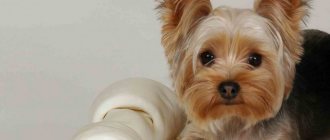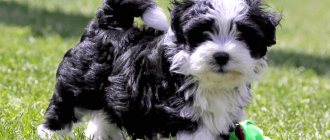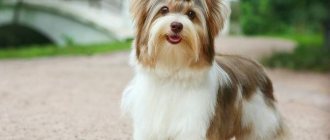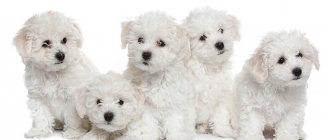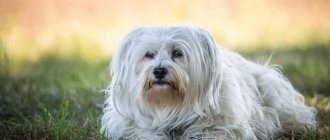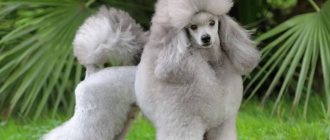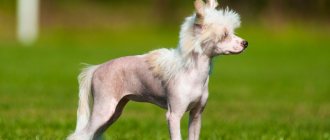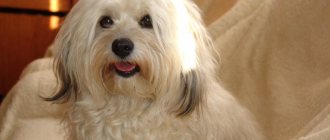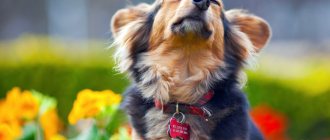In this article we will tell you about the breed of the most beautiful miniature dogs with long hair - the Havanese Bichon, which is also called the Havanese, Havanese, Havanese. You will learn about the standard of appearance and character traits of representatives of this breed, and maybe decide to get yourself such a pet if you need an unpretentious, cheerful companion and devoted friend.
History of the origin of the breed
There are two versions of who the Havanese may come from - the official and the alternative. According to the official version, they were obtained from matings of Maltese and Italian lapdogs (Bolognese), which came to Malta with settlers and colonialists from Spain. But this cannot be confirmed. According to an alternative version of the origin, the Havanese descended from the Tenerife lapdog, which crossed with other lapdogs and poodles in the Canary Islands.
The Cuban aristocracy welcomed the Havanese Bichon, but at the beginning of the 20th century the breed began to die out. It was preserved only thanks to the efforts of American amateurs who bred lapdogs.
The end of the 20th century became the time of the conquest of Europe for the Havanese. Here they have become popular not only among professional dog handlers, but also among amateur owners due to their calm but friendly character.
The Havanese Bichon is the national breed of Cuba.
Havanese Bichon price
It is believed that the most promising Havaneses should be looked for in the USA, although American breeders are not eager to send puppies with excellent exterior characteristics abroad. As for the cost, you won’t be able to buy a purebred Havanese Bichon in the States for less than $1000-1500. Havanese dogs from Russian nurseries are cheaper - from 30,000 rubles for a pet-class puppy. It is better not to respond to offers with a lower price tag that are found on virtual bulletin boards. In most cases, they are placed by sellers of mixed breeds and undocumented animals.
Description of the breed
Havanese walk with their heads held high, giving the impression of being little proud people. But that's not true. Their springy gait is due to the length of their front legs, which are slightly shorter than their hind legs.
Breed standard
Torso:
- compact, rectangular format with a length-to-height ratio of 4:3,
- strong but not heavy skeleton,
- tail set high, raised in a ring above the back.
Head:
- small size,
- slightly narrowed muzzle,
- dense, dry black lips,
- hanging, wide-set ears,
- black or brown eyes, well-pigmented eyelids, dark nose,
- full set of teeth, scissor bite.
Legs:
- short, straight, strong bones,
- paws are collected in a ball, oval.
Wool:
- thick, soft undercoat, moderately soft guard hair, springy when touched,
- hair is long (up to 18 cm), wavy (including ears, legs and tail dewlap),
- forms a parting on the crown,
- any color (except for white, cream, golden, silver, chocolate, black, blue and their combinations are acceptable; mono-colored is better).
Character and behavioral characteristics
The open, friendly nature, rare among small breed dogs, is the most attractive feature of the Havanese Bichon. They are very affectionate: both puppies and adults follow a person with their “tail”. They love their owner endlessly, they miss him and would prefer not to part with him even at night. They react quickly to praise and reprimand.
Always playful and affectionate, Havanese are great for families with children and get along well with other dogs and cats. They are not leaders - they do not protect territory, toys and food. As an island breed, they are excellent swimmers and love to play in the water. Dogs that are not socialized enough can be fearful.
Havanese Bichons “treat” people, which is why they often work as canine therapists.
Animal character
All representatives of this species are friendly and very affectionate, with a playful disposition. They are very attached to their owner and are ready to follow him everywhere. Even short-term separation from a person causes them anxiety. This dog is not suitable for people who are often away from home.
This is a companion dog. They are ready to communicate even with strangers, which is why they are used for animal psychotherapy.
They love children and willingly play with them. They get along easily with other pets.
Positive qualities of the breed:
- friendly, cheerful, affectionate
- can live both in a private house and in a city apartment
- suitable for people with allergies
- are easy to train and enjoy performing tricks
- love children
- get along with other animals
Flaws:
- require constant attention
- beautiful coat requires regular care
These babies are absolutely not aggressive and very good-natured
Education and training
Havanese Bichons are easy to train and even beginners can handle it. Dogs of this breed are smart and love to learn, so they can quickly master a large number of tricks. The dog is still learning the basic habits (to relieve himself in the litter box, sleep in his place, don’t beg, don’t bother the owner, don’t spoil things) and commands (“Come to me!”, “Near!”, “Sit!”) for participation in exhibitions. in puppyhood, and does it without difficulty. Suitable for agility and flyball. In addition to the functions of a pet, the Havanese can be trained to be a guide for the blind and a termite and mold detector.
Characteristics of Havanese
| Attachment level | High |
| Friendliness | High |
| Child Friendly | High |
| Loyalty to other pets | High |
| Exercise needs | Average |
| Playfulness | High |
| Energy level | Average |
| Learning ability | High |
| Intelligence | Average |
| Tendency to bark | Low |
| Shedding amount | Low |
Diseases and care
The health of the Havanese as a breed is not ideal. Common diseases of the Havanese Bichon:
- Cataract, retinal detachment (signs: lacrimation, corneal clouding, photophobia, hyperemia of the mucous membranes of the eye; diagnosis and treatment in the early stages can save the animal’s vision);
- Otitis, inflammation of the ears (signs: hot, painful ear, excess wax; in the hanging ears of lapdogs, an environment favorable for inflammation is easily created);
- Medial dislocation of the patella (signs: mobile (shifting) patella, lameness),
- Hip dysplasia (difficulty and pain when moving and lifting, “rabbit” running, lameness in the hind legs).
Havanese is vaccinated against common infectious diseases of dogs (rabies, leptospirosis, distemper, parvovirus enteritis, infectious hepatitis, adenovirosis) according to the following scheme:
- The first complex vaccination - at the age of 2 - 3 months,
- Revaccination (with the same vaccine) - after 2 - 3 weeks,
- The second complex vaccination - at the age of 6 months (after changing teeth),
- Rabies vaccination at 12 months of age.
Further, mandatory annual vaccination against rabies, against other infections - optional. After each vaccination, keep the dog in quarantine for 12 days: do not walk, do not allow contact with animals, do not overcool, do not overfeed. The long-haired Havanese Bichon is never cut: cutting damages its coat. But it is regularly combed and washed as necessary.
For washing, choose dog cosmetics (shampoo, conditioner, conditioner), but make sure that your pet is not allergic to it. Havanese sheds lightly all year round, but in autumn and spring this process is more intense. Brushing and combing will solve the problem of hair in the house. His fur will protect him from overheating, but will not protect him from the cold in winter - dress your pet in warm dog clothes for walks.
Clean the ears (the visible part of the auricle) with cotton swabs soaked in lotion. Do not try to clean the depths of the ear canal: it may become clogged with cotton wool and wax. To prevent fur from clogging the ears, trim it completely from the inside of the shell. Trim the claws once a month, shortening them by 1 - 2 mm, no more, so as not to injure the blood vessels. With regular trimming, the living tissue in the claws will “retreat” to the fingers.
Basic moments
- The breed has the status of rare and exclusive. There is little information about her on Russian-language forums, and there are only a few domestic nurseries engaged in breeding purebred Havanese.
- The rarest color of the Havanese Bichon is white, the most common is tobacco.
- The signature feature of the breed is phenomenal contact. Therefore, Havanez dogs are recommended for people of retirement age, as well as owners suffering from loneliness and panic attacks.
- The breed is easy to train, so even owners without experience with decorative dogs can find contact with its representatives.
- Havanese Bichons are not cut, but you still have to learn the basics of professional hair care - animals shed lightly, so dead hairs must be combed out yourself.
- Loneliness, even for a few hours, is extremely stressful for the Havanese Bichon. Therefore, before you adopt a dog, think about who will brighten up its everyday life when you are at work.
- In the United States, Havanese dogs have a reputation as “alarm” dogs, recommended as a pet for families with hearing-impaired children.
The Havanese Bichon is a funny little cutie that can drown in a sea of love and charm anyone who is ready to gently cuddle him or scratch him behind the ear. The Cuban Havanese is still a rare guest in Russian apartments, but this does not mean that the breed is not valued by breeders. It’s just that, due to historical circumstances, animals could not get into exhibitions and breeding lists of cynological associations for a long time. Today, the Havanese is one of the most prestigious and exclusive pets in the world, the acquisition of which will require not only a tidy sum, but also months of searching and waiting.
Feeding
Bichons are a decorative breed of dog, so their nutrition should, first of all, be aimed at developing and maintaining a beautiful and healthy appearance. Take meat products, grains and vegetables as the basis for a natural diet. Sometimes add eggs, dairy products, herbs, fish and fruits. Feed your dog an age-appropriate multivitamin regularly. Under no circumstances should you feed sweet, salty, sausages or food from your table.
If you don’t want to select and prepare your dog’s food yourself, switch it to dry complete food of super premium and holistic classes, while completely eliminating additional vitamins in dry food so as not to cause an overdose.
Nutrition
A Havanese Bichon puppy needs to eat plenty of meat and dairy products to ensure its skeleton and muscles develop properly. It is recommended to finely chop chicken or rabbit meat for him every day (mono combine), and also give him fresh cow's milk.
Thanks to regular consumption of proteins, the dog progressively gains muscle mass and becomes healthier. We also recommend giving her soups, borscht and broths to improve digestion. In addition, you can include in your pet’s menu:
- Cereals.
- Mashed potatoes.
- Berries, vegetables and fruits.
- Fish (without bones).
But you can’t give him sweets and smoked foods. Remember, the Cuban lapdog is an excellent manipulator, who, at the sight of a delicious cake, can look at you pitifully and whine, begging for it. You can't agree!
After eating difficult-to-digest and high-carbohydrate foods, dogs experience digestive dysfunction. When the puppy turns 1.5 years old, we advise you to change his diet from natural to ready-made, that is, give him food (wet or dry).
Mating, pregnancy and childbirth
Female Havanese Bichons begin to go into heat between 6 and 12 months of age and repeat every 6 to 9 months. Never breed a female dog in her first heat: the body of a recent puppy is not yet strong enough to bear offspring. Find out the duration of estrus specifically for your dog: to do this, observe the bitch more than once or twice. Typically this period is 20 - 22 days. It is better to breed with a male dog on the 11th - 15th day and again a day later - two. Mating is best done in the boy's territory. It is ideal if the animals are comparable in height. But if the difference is big, place a pillow under the hind legs of the dog or bitch.
The Havanese Bichon's pregnancy lasts 59 ± 3 days. It is important to know exactly the gestational age, since prematurity and postmaturity threaten the puppies with death. To do this, always write down the mating dates. Young dogs (up to 3 - 4 years old) have small litters, which is why pregnancy may last longer than usual. In the first three weeks, the bitch’s behavior changes (she becomes more affectionate), but there are no external signs. After a month, the belly grows and the mammary glands enlarge.
Signs of imminent labor:
- prolapse of the abdomen,
- greenish or yellowish discharge from the loop,
- decrease in rectal temperature to 37 degrees and below.
Prepare your birth kit:
- disposable diapers (put under the bitch),
- ironed cloths (to receive and dry puppies),
- dishes (put away afterbirth),
- a box for puppies with a heating pad (if the bitch is restless, and newborns should not be placed in it),
- surgical clamp and scissors (for cutting the umbilical cord; treat with alcohol),
- antiseptic spray Septonex, Aluminum or Xidikol (for treating the umbilical cord wound),
- scales, notebook, pen, thick thread of floss (weigh and mark puppies, write down the results).
If the birth is successful, then no medications or other means of resuscitation are needed. If not, the veterinarian you call will have everything you need with you.
Reproduction and lifespan
Lapdogs faithfully serve their owner for about 14 years. Some of them live up to 15-16 years. Before breeding them, you should study the standardization of each species. For example, the breeder must understand how the Cuban lap dog differs from, for example, the Bichon Frize.
Only previously acquainted males and females who are not relatives are brought together. Dogs are bred on the 4th day of the female's heat, because this is how she will most likely become pregnant. The fact that conception has occurred is indicated by the noticeable rounding of her abdomen.
How to choose a puppy
Requirements for animals:
- puppy not younger than 2 - 3 months,
- compliance with the standard (even dark pigmentation of the nose and eyelids, eyes not sunken or bulging),
- good health (active movements, clean, healthy eyes and ears, strong, straight legs without unevenness),
- correct character (cheerful, curious, fearless, timid),
- availability of treatments and vaccinations, documents, stamps.
Requirements for conditions of detention:
- cleanliness of the room, dishes and toys,
- good complete food
- calm healthy mother.
Choosing a nickname
The source of inspiration is the names of celebrities, historical figures, mythological and literary heroes, place names and even the character and appearance of the pet. Choose a sonorous, clearly pronounced nickname that you won’t get tired of after you call your dog for the twentieth time that day.
| Suitable for girls: | Audrey, Sarah, Klepa, Missy, Luna, Camry, Vesta, Belka, Nusya, Ganga. |
| For males: | Guy, Ollie, Jerry, Rain, Fet, Drona, Brom, Quinn. |
Owner reviews
Anya K.
“We bought a bichon for our daughter to develop her sense of responsibility, and the dog coped with it perfectly. For two years now she has been a favorite with the whole family, does not bark, does not smell, does not shed. Lyalya never asks to go for a walk on her own; she prefers to stay in the apartment, so we don’t go for walks according to schedule. She is so kind that it seems that she is not a dog at all, but a canine angel. And smart at the same time.”
Violetta D.
“Our black Motya is just an amazing dog. She is good-natured and cheerful, loves our children very much, and this is mutual. It is not true that they are wary of strangers: Motya will treat a stranger kindly if he shows positive attention to her, for example, expresses a desire to pat her on the head or pat her withers. She's just happy about it. When she runs, it’s just a hilarious sight and endless happiness: her ears jump up with her.”
Similar breeds
Maltese (Maltese) is an affectionate, cheerful dog with perfectly white, elegant fur. She has a sensitive, good-natured character, but strangers often frighten her or cause aggression.
Bichon Frize are playful, sincere and intelligent miniature dogs similar to the snowy white poodle, making a wonderful gift for yourself or a loved one.
The Coton de Tulear is a small decorative dog with lush “cotton” fur, originally from the island of Madagascar. Related to Bichons, they are included in the same group of decorative dogs.
Bolognese is a “French lap dog” of Italian origin. He inherited a charming appearance from lapdogs, and a curly coat structure from poodles.
Shih Tzus are traditional Chinese dogs, their homeland is Tibet. Like the Maltese, the Chinese lion cub has the longest fur in relation to the body.
Briefly about the main thing
- The Havanese Bichon is a cheerful, friendly, easy-going dog breed.
- Havanese are easy to care for and do not require grooming or frequent washing.
- This is a smart, easy to train breed.
- Havanese dogs are energetic, but do not need physical activity; indoor living is acceptable.
Tell us in the comments about your Havanese's funniest habits and skills.
Did you like the article? Share it with your friends on social media. networks. This will help them get useful information and support our project.
